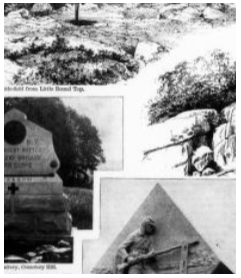Did Photo Journalism Invent the Comics Gutter?

This is the third of three posts focused on the 1891 weekly run of Frank Leslie’s Illustrated Newspaper (here are links to the first and second). I’ve been intrigued by how much the multi-image full-page artwork prefigures twentieth-century comics norms:

But I’ve been holding back on one major fact, which, for me, changes my understanding of comics history.
I’ve not (yet) done any detailed, quantitative analysis, but I’m going to say that as much as half of the newspaper’s 1891 “illustrations” are photographs. That means that instead of the above full-page drawing, many of the pages look like this:

Leslie’s is a big fan of the two-page spread, where photographs were possibly more common in 1891:

The most defining layout quality of the photo-based pages is the rectangular shape of the images (many cropped to suit page proportions) and the resulting white gutters produced by the negative spaces between them. Even when a photograph receives an oval frame, the rectangular outer frame edge remains:

Of course drawn images can have rectangular frames too. Note the bottom right drawing on this page:

But unlike photographs, drawings can be unframed. Note on the next page how the small drawn figure in the third row is visually accented because it’s the only image without a uniform gutter:

The effect is more subtle for the bottom corner drawings on this page, because the drawn content includes backgrounds, creating a nearly rectangular image shape:

This next two-page spread includes four drawings, mostly shaped by the surrounding rectangular photos. The bottom right drawing, however, has far more open white space, producing a hazier sense of image edges. Also, the middle image is one of the only oval-cropped photographs I found in the 1891 run:

The effects of combining drawings and photos shift when the two kinds of images are separated into distinct page areas.
Note how the two unframed drawings in the upper right side produce no gutter, but the top center drawing’s frame produces a full gutter with the photograph beneath it:

Here the two approaches occur in separate rows:

Note the multiple contrasts: The top row features two full vertical gutters dividing the three rectangular photos. The bottom row instead features seven (or eight?) images divided by irregularly shaped and spaced white areas. The elbow of the far right figure is drawn nearly touching the back of the figure to the left, even though the two images are diegetically distinct. At the other extreme, the white areas dividing the three heads on the left side of the row are multiple times wider than the vertical gutter directly above.
Drawn images also regularly overlap, where photo layouts are always consistently spaced:

Drawn frames of course aren’t actual frames. They’re drawings of frames. In some cases, artists make that fiction explicit:

Note the division between the two images in the second row. The second is surrounded by an ornately drawn frame:

The photographs directly above and below instead provide sharp horizontal lines of partial horizontal gutters.
In all of the 1891 run, I could only find one instance of a photograph tilted out of alignment with the paper edges. It’s also the only example of photographs overlapping:

Leslie’s layout usually creates overlap effects by cutting out portions of photos and extending the gutters:

The arrangement style is common in 20th-century comics. This 1937 Alley Oop includes five examples, including all of its interior borders:

Leslie’s sometimes uses both border approaches on the same page:

Note how the two unframed drawings are divided by imprecisely edged white space, and the two photos are spaced by multiple right-angled gutter shapes that prevent overlap:

Leslie’s often places the two kinds of pages, photo layout and drawn, side-by-side:

And even when no or few photos are involved, the images on a page can be arranged in an actual layout of individual physical images combined by a layout artist on a newspaper’s layout board or images can be integral parts of a single unified drawing involving no actual layout:

That juxtaposition makes explicit something that now seems obvious to me but that I never considered before.
What we call a “layout” in comics isn’t layout. It’s a drawing of a layout.
Actual layout is “the process of setting out material on a page.” The key word is “material.” A drawing doesn’t arrange discrete materials. When a Leslie’s page includes a photo or a discrete drawing, layout is involved and often results in creating gutters between those rectangular materials. When a page is entirely drawn, the only layout is the rudimentary act of placing the one-page piece of artwork on the printer board with a page number and title in the header. That’s obvious when the page looks like this:

But it’s equally true for a page that looks like this:

Or this:

Or this:

A comics layout isn’t a kind of layout. It’s a representation of a fictional layout. And what we call a “gutter” is usually a representation of a gutter, since no two material objects (prototypically rectangular photos) are actually placed next to each other during any actual layout process. It’s all just a drawing.

This leads to a historical question:
Why did comics artists start drawing representations of gutters that look like the gutters produced by laying out photographs in late 19th-century illustrated newspapers?
I don’t know, but I suspect it’s because those artists were aware of those (actual) layouts and were imitating them. I also suspect that at some point the fact of that historical influence was lost as the drawing approach became a comics norm and “layout” came to refer to a drawn quality of the artwork itself.
Those are my hypotheses.
Lots more research required.
Chris Gavaler's Blog
- Chris Gavaler's profile
- 3 followers



